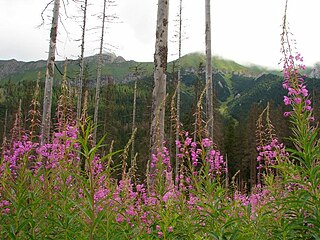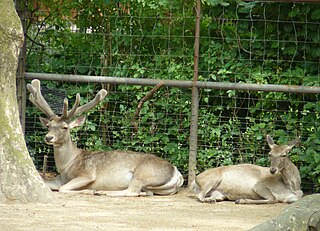
Central Asia is a subregion of Asia which stretches from the Caspian Sea in the west to China and Mongolia in the east, and from Afghanistan and Iran in the south to Russia in the north. The region consists of the former Soviet republics of Kazakhstan, Kyrgyzstan, Tajikistan, Turkmenistan, and Uzbekistan. It is also colloquially referred to as "The -Stans" as the countries all have names ending with the Persian suffix "-stan", meaning "land of".

Turkmenistan is a landlocked country in Central Asia, bordering the Caspian Sea to the west, Iran and Afghanistan to the south, Uzbekistan to the north-east, and Kazakhstan to the north-west. It is the southernmost republic of the Commonwealth of Independent States (CIS), the loose federation created at the end of 1991 by most of the Post-Soviet states.

In physical geography, a steppe is an ecoregion characterized by grassland plains without trees apart from those near rivers and lakes.

A woodland is, in the broad sense, land covered with trees, or in a narrow sense, synonymous with wood, a low-density forest forming open habitats with plenty of sunlight and limited shade. Woodlands may support an understory of shrubs and herbaceous plants including grasses. Woodland may form a transition to shrubland under drier conditions or during early stages of primary or secondary succession. Higher-density areas of trees with a largely closed canopy that provides extensive and nearly continuous shade are often referred to as forests.

The Bactria–Margiana Archaeological Complex or Oxus Civilization, recently dated to c. 2250–1700 BC, is the modern archaeological designation for a Bronze Age civilization of Central Asia, previously dated to c. 2400–1900 BC, by Sandro Salvatori, in its urban phase or Integration Era.

The Caucasus-Anatolian-Hyrcanian temperate forests is a composite ecoregion of southern Europe and West Asia, designated by the World Wildlife Fund as one of their Global 200 ecoregions, a list of priority ecoregions for conservation.
The Irano-Anatolian region is a biodiversity hotspot designated by Conservation International, extending across portions of Armenia, Azerbaijan, Georgia, Iraq, Iran, Turkey, and Turkmenistan.

Eremurus is a genus of deciduous perennial flowers, also known as the foxtail lilies or desert candles. They are native to eastern Europe in and temperate Asia from Turkey to China.
Pyrus boissieriana, the Boissier pear and telka, is a species of Pyrus (pear) native to the Kopet Dag region on the Turkmenistan and Iranian border. In its native locales it is cultivated as a rootstock for domestic pears.

The list of Turkmenistan-related articles is below

The wildlife of Turkmenistan is the flora and fauna of Turkmenistan, and the natural habitats in which they live. Turkmenistan is a country in Central Asia to the east of the Caspian Sea. Two thirds of the country is hot dry plains and desert, and the rest is more mountainous. Very little rain falls in summer and the chief precipitation occurs in the southern part of the country in the winter and spring. The Caspian coast has milder winters.

The conquest of Central Asia by the Russian Empire took place in the second half of the nineteenth century. The land that became Russian Turkestan and later Soviet Central Asia is now divided between Kazakhstan in the north, Uzbekistan across the center, Kyrgyzstan in the east, Tajikistan in the southeast and Turkmenistan in the southwest. The area was called Turkestan because most of its inhabitants spoke Turkic languages with the exception of Tajikistan, which speaks an Iranian language.
Pipistrellus aladdin, the Turkestan pipistrelle, is a species of bat in the family Vespertilionidae. It is found in Central Asia and Afghanistan. It is assessed as data-deficient by the IUCN.

The Central Asian riparian woodlands ecoregion is spread out across the deserts and plains of central Asia between the Aral Sea and the mountains 2,000 kilometres (1,200 mi) to the east. The long narrow components of the ecoregion follow the large rivers fed by snowmelt, and provide critical habitat for migratory birds as they travel through the arid region. The vegetation is referred to as tugai, characterized by low tangles of trees and brush along the edges of the rivers and associated wetlands, and fed by groundwater instead of precipitation.

The Central Asian southern desert ecoregion is an arid but ecologically active region between the east coast of the Caspian Sea and steppes at the base of the mountains of central Asia. Most of Turkmenistan and eastern Uzbekistan is in this ecoregion. The winters are milder than in the cold desert to the north, and a large number of endemic species have adapted to living in the particular climate and soil of the region. As with sandy deserts in general, the region is notable for high numbers of endemic species of reptiles and insects.

The Kopet Dag semi-desert ecoregion is a small ecoregion that crosses the border of southwestern Turkmenistan into northeastern Iran. It covers a transition zone between the deserts to the north and west, and the foothill steppes and woodlands in the higher Kopet Dag mountains to the east and the Alborz Mountains to the south. The terrain is mostly barren semi-desert and widespread 'takir', a type of seasonal salt flat or dried clay deposit in an interdune depression.

The Kopet Dag woodlands and forest steppe ecoregion coincides with the Kopet Dag mountains, straddling the southern border of Turkmenistan and the northeastern border of Iran. The region is one of high biodiversity, as it includes a full range of altitude zones, and variety of habitats included juniper-wooded slopes, montane grasslands, and tugay.

The Badghyz and Karabil semi-desert ecoregion covers the hills north of the central mountain ranges of Afghanistan, southeast Turkmenistan, and portions of Uzbekistan and Tajikistan. The landscape has been described as "savannah-like" and reminiscent of Africa, with desert sedges (Carex) and stands of wild pistachio trees. The area supports high biodiversity and a number of rare and endemic species, such as the endangered Turkmenian kulan (Equus hemionus kulan).














